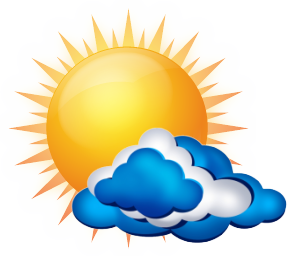
| :
|
Local Time.
Time Zone: GMT -3
Winter Time
* weather indicated in local timeThursday, March 6, 2025
| Sun: | Sunrise 05:28 AM, Sunset 05:42 PM. |
| Moon: | Moonrise 11:39 AM, Moonset 11:27 PM,  |
| Earth's magnetic field: Quiet |
| 09:00 PMeveningfrom 09:00 PM to 09:59 PM |  +75 °FLight rain +75 °FLight rain |

Wind: light breeze, southeast, at a speed of 4 mph
Wind gusts: 11 mph
Relative humidity: 89%
Cloudiness: 75%
Atmospheric pressure: 29,1 "Hg
Precipitations: 0,004 inch
Visibility: 100%
On the ground:
Wind felt on face; leaves rustle; ordinary vanes moved by wind.On the sea:
Small wavelets, still short, but more pronounced. Crests have a glassy appearance and do not break.Wind gusts: 11 mph
Relative humidity: 89%
Cloudiness: 75%
Atmospheric pressure: 29,1 "Hg
Precipitations: 0,004 inch
Visibility: 100%
| 10:00 PMeveningfrom 10:00 PM to 10:59 PM |  +72 °FLight rain +72 °FLight rain |

Wind: light breeze, southern, at a speed of 4 mph
Wind gusts: 11 mph
Relative humidity: 90%
Cloudiness: 75%
Atmospheric pressure: 29,1 "Hg
Precipitations: 0,004 inch
Visibility: 84%
Wind gusts: 11 mph
Relative humidity: 90%
Cloudiness: 75%
Atmospheric pressure: 29,1 "Hg
Precipitations: 0,004 inch
Visibility: 84%
| 11:00 PMeveningfrom 11:00 PM to 11:59 PM |  +72 °FLight rain +72 °FLight rain |

Wind: light air, southern, at a speed of 2 mph
Wind gusts: 7 mph
Relative humidity: 91%
Cloudiness: 76%
Atmospheric pressure: 29,1 "Hg
Precipitations: 0,004 inch
Visibility: 78%
On the ground:
Direction of wind shown by smoke drift, but not by wind vanes.On the sea:
Ripples with the appearance of scales are formed, but without foam crests.Wind gusts: 7 mph
Relative humidity: 91%
Cloudiness: 76%
Atmospheric pressure: 29,1 "Hg
Precipitations: 0,004 inch
Visibility: 78%
weather in São José da Lajetemperature in São José da Lajehourly weather forecast in São José da Lajeweather in São José da Laje tomorrowweather in São José da Laje for 3 daysweather in São José da Laje for 5 daysweather in São José da Laje for a weeksunrise and sunset in São José da Lajerising and setting of the Moon in São José da Lajecurrent time in São José da Laje
Temperature trend on the chart
Weather in Nearby Cities
IbateguaraUnião dos PalmaresQuipapaCanhotinhoSantana do MundauSantana do MundaúMuriciMaraialFlexeirasSão JoãoColônia LeopoldinaCapelaViçosaCupiraNovo LinoMessiasLajedoGaranhunsCatendeJundiáAtalaiaRio LargoQuebranguloAltinhoMatriz de CamaragibeCachoeirinhaAgrestinaPalmaresSão Luís do QuitundePilarSatubaAgua PretaCaetésMaribondoCapoeirasSão Joaquim do MonteBonitoBom ConselhoJoaquim NabucoPorto CalvoBarra de Santo AntônioCoqueiro SecoPalmeira dos IndiosGuabirabaCamocim de Sao FelixAnadiaMarechal DeodoroMaceioCaruaruBelo JardimTaquaranaSão Miguel dos CamposIgaciGameleiraCajueiroCoité do NóiaBezerrosCampo AlegreMaragogiRibeiraoMinador do NegrãoLimoeiro de AnadiaAmarajiBarreirosSão José da Coroa GrandePesqueiraBrejo da Madre de DeusGravataRio FormosoArapiracaChã GrandeTamandaréCacimbinhasJunqueiroToritamaPedraSirinhaémSão SebastiãoEscadaMajor IsidoroAguas BelasLagoa da CanoaCumaruSanta Cruz do CapibaribePombosDois RiachosTaquaritinga do NortePassiraCoruripeArcoverdeIpojucaGirau do PoncianoBuiqueVitória de Santo AntãoSurubimOlivençaSantana do IpanemaJoao AlfredoCaboCabo de Santo Agostinho
Some useful data
| Brazil | |
| +55 | |
| Alagoas | |
| Sao Jose Da Laje | |
| São José da Laje | |
| America/Maceio, GMT -3. Winter Time | |
| Latitude: 9°0'35" S; Longitude: 36°3'30" W; |


